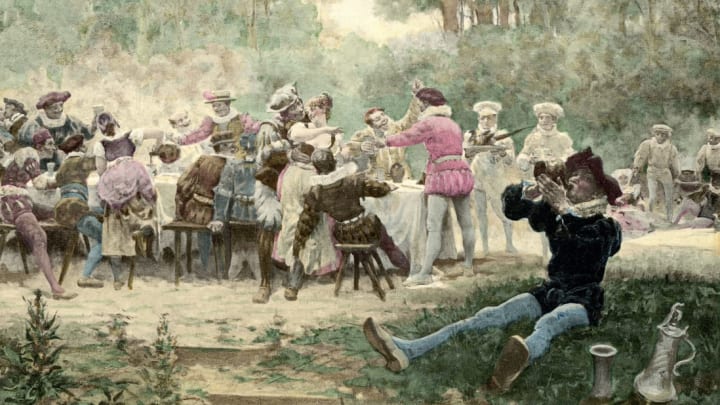8 Medieval Christmas Traditions to Liven Up Your Holiday Party

Even before the rise of Santa Claus, indoor trees, and 24-hour holiday radio, Christmas was a cause for celebration. The holiday dates back to the 4th century when Pope Julius I declared December 25 to be the date of Christ’s birth. By the end of the 8th century, believers throughout Europe were marking the season with feasts, drinks, and all-around debauchery. Here are some of the more colorful ways Christmas was celebrated in the Middle Ages.
1. WASSAILING
Wassailing was one of the many pagan customs adopted by Christmas revelers. The term wassail comes from the Anglo-Saxon greeting waes-hael, which means “be in good health.” As the tradition evolved, the word became synonymous with the hot mulled apple cider drink distributed during Yuletide. Carolers would take their wassail bowl door-to-door, offering a drink and a song in exchange for gifts. While the tradition of caroling at Christmas still persists today, modern singing troupes usually leave the booze at home.
2. SACRIFICING BOARS
People living in the Middle Ages couldn’t pick up a ham from the supermarket for Christmas, so they did the next best thing: They sacrificed a wild boar. If you wanted to impress your guests around the holidays, nothing was more striking than the head of a boar presented with an apple in its mouth on a silver platter. Of course, not every family could afford to serve a Yule boar at their Christmas dinner. For households that were less well off, a pie in the shape of a pig was a popular alternative.
3. KING OF THE BEAN
King cakes with tiny plastic baby dolls baked into them have become a Mardi Gras staple, but the first version of the tradition originated with winter solstice. Cakes containing a single bean were consumed during pagan solstice celebrations, and whoever found the bean in their slice became “king” for a year. Following a year of rule, the temporary king was sacrificed and his blood spilled onto the earth to promote another year of good harvest. When medieval Christians adopted this practice for Christmas they made some adjustments. Whoever found the bean in their cake wasn’t sacrificed, but the tradeoff was that they only got to be king for a day instead of the whole year.
4. JULEBUKKING
Imagine trick-or-treating, only creepier, and you’ll have a good idea of what julebukking was like. As is the case today with Halloween, Scandinavians celebrating Christmas in the Middle Ages would don masks and costumes and go door-to-door looking for treats. But the julebukkers weren’t cute kids: They were usually drunk adults. The practice isn’t as popular as it was in medieval times, but it’s still observed by some Norwegians and even Americans of Scandinavian descent.
5. MYSTERY PLAYS
Mystery plays were a popular form of entertainment for medieval audiences around the winter holidays. Actors, usually clergymen, performed stories from the Bible in either traditional Latin or the common vernacular. No story was off-limits, with the end of days and King Herod's massacre of the innocents playing out on the same stage as the Nativity (though having monks stand in for evil characters like Lucifer did raise some eyebrows).
6. GIVING GIFTS TO RICH PEOPLE
Today, gift-giving is an opportunity to encourage goodwill and generosity around the holidays. In the Middle Ages, it was a way to exploit the poor. Kings and queens throughout Europe required tributes from their subjects on Christmas in the spirit of the three Magi giving gifts to baby Jesus. Soon, lower-ranking noblemen like lords of manors started requesting their own gifts. Even though they were the poorest people in the kingdom, the peasants received nothing in return. According to legend, the 10th century Bohemian duke Wenceslas I (posthumously elevated to king) was among the first rulers to reverse the trend when he spent the holidays handing out food, clothes, and firewood to the less fortunate.
7. LORD OF MISRULE
If you want your holiday party to run more smoothly (or less smoothly, depending on how you look at it), consider appointing a Lord of Misrule. Traditionally, this person was tasked with overseeing the Feast of Fools: an early-winter holiday that flipped the normal social hierarchy upside down. After he was elected, the Lord of Misrule and his court of merrymakers paraded down the street wearing masks and playing instruments. The procession ended at church where the fools interrupted whatever service was going on by bringing their song and dance inside. The number-one rule during the feast was to obey the Lord of Misrule. Fortunately for revelers, most of his commands involved drinking more and having fun.
8. GAMBLING
Gambling was right up there with eating, singing, and drinking at the Christmas parties of the Middle Ages. Both kids and adults took part in the activity, and even if gambling wasn’t a part of their life, people made an exception for the winter holidays. The most popular games involved dice, and players threw them down on any surface they could find, including church altars.